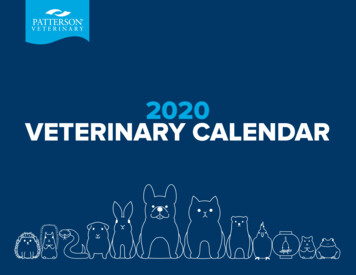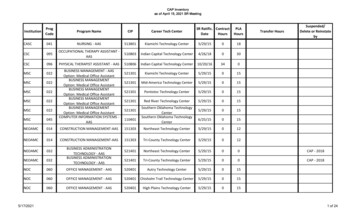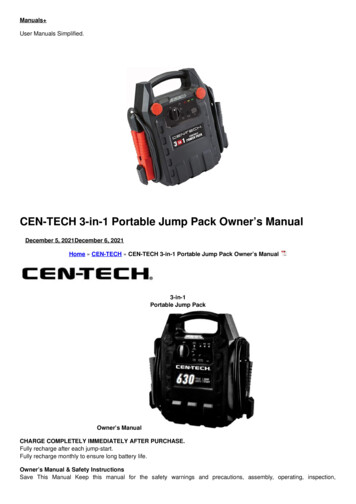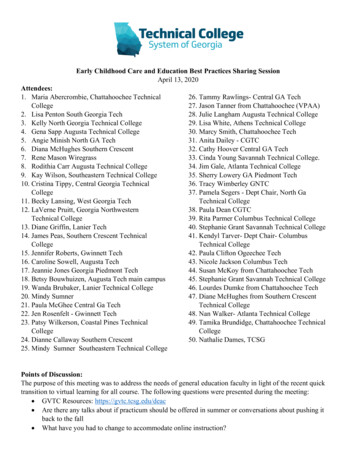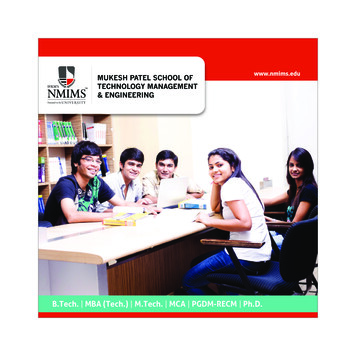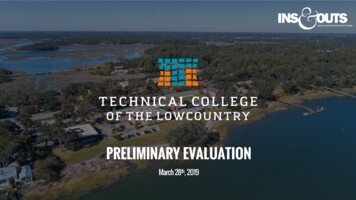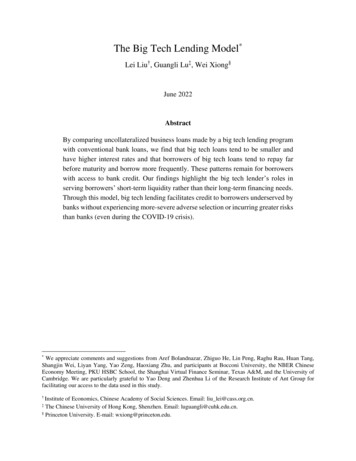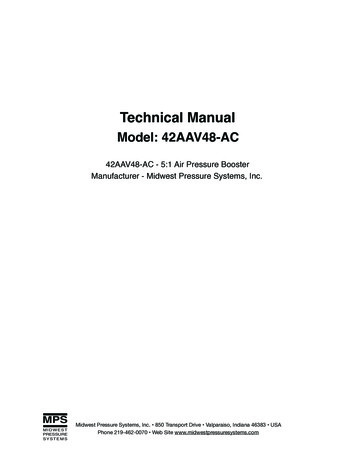
Transcription
Operating and Maintenance Manual Model: 42AAV48-AC 5/16/14 Rev. 1Technical ManualModel: 42AAV48-AC42AAV48-AC - 5:1 Air Pressure BoosterManufacturer - Midwest Pressure Systems, Inc.MPSMIDWESTPRESSURESYST E M SMidwest PressurePressure Systems,Systems, Inc.Inc. 850850 TransportTransport DriveDrive Valparaiso,Valparaiso, IndianaIndiana 4638346383 USAUSAMidwestPhone 219-462-0070 Web Site www.midwestpressuresystems.comPhone 219-462-0070 Fax 219-318-2277Web Site www.midwestpressuresystems.comPage 1
Operating and Maintenance Manual Model: 42AAV48-AC 5/16/14 Rev. 1Midwest Pressure Systems, Inc. 850 Transport Drive Valparaiso, Indiana 46383 USAPhone 219-462-0070 Fax 219-318-2277 Web Site www.midwestpressuresystems.comPage 2
Operating and Maintenance Manual Model: 42AAV48-AC 5/16/14 Rev. 1Table of Contents1. Design Specifications2. Materials of Construction and Torque Specifications3. Flow Curves4. Boost Cylinder Operation5. Drive Air System Operation6. Installation7. Startup8. Operation9. Maintenance & Warranty10. General Booster Arrangement Drawing11. Booster Assembly Drawing12. Booster Assembly with Air ControlsMidwest Pressure Systems, Inc. 850 Transport Drive Valparaiso, Indiana 46383 USAPhone 219-462-0070 Fax 219-318-2277 Web Site www.midwestpressuresystems.comPage 3
Operating and Maintenance Manual Model: 42AAV48-AC 5/16/14 Rev. 1Page 41. Design SpecificationsMidwest Pressure Systems, Inc. (MPS) air pressure boosters are designed for ease of operation andmaintenance. Experience has shown that an MPS booster will normally provide years of satisfactoryperformance with minimal maintenance. Carefully review this manual which is designed to provideinformation on installation, start up, operation and maintenance. If you have questions, pleasecontact Midwest Pressure Systems, Inc. Model 42AAV48-AC is designed for air pressure boosting.Booster design meets these ATEX specifications:0575II 2 G T4Designed in accordance with ASME Boiler and Pressure Vessel Code, Section VIII, Division 1Model 42AAV48-AC Engineering SpecificationsMaximum process air discharge pressure - psi (bar)Process Air temperature range - F ( C)696 (48)32 to 167 (0 to 75)Maximum cycle rate - cycles per minute (Note 1)Process Air displacement per cycle - cf (liters)Maximum process air displacement - cfm (liters per minute)100.016 (.453)1.6 (45.3)Pressure boost (multiple of drive air pressure) (Note 2)3.2Process Air discharge connection FNPT1/4Seal vent connection FNPT1/8Maximum drive pressure - psi (bar)Air temperature range - F ( C)Air displacement per cycle - cf (liters)Maximum air displacement - cfm (liters per minute)125 (8.6)32 to 167 (0 to 75).069 (1.95)6.9 (195)Drive air inlet connection FNPT1/2Drive air exhaust connection FNPT1/2Drive air cylinder bore diameter - inches (millimeters)4 (102)Process Air boost cylinder bore diameter - inches (millimeters)2 (50.8)Piston rod diameter - inches (millimeters).625 (15.9)Stroke - inches (millimeters)4.8 (122)Weight - pounds (kilograms)35 (15.9)Ambient Temperature - F ( C) (Note 3)-15 to 167 (-26 to 75)Note 1: A cycle consists of a forward and reverse stroke.Note 2: This is a nominal operating pressure boost ratio, not the maximum pressure boost ratio.Note 3: Where ambient temperatures fall below 0 C (32 F) a heater is required for the drive air.Midwest Pressure Systems, Inc. 850 Transport Drive Valparaiso, Indiana 46383 USAPhone 219-462-0070 Fax 219-318-2277 Web Site www.midwestpressuresystems.com
Operating and Maintenance Manual Model: 42AAV48-AC 5/16/14 Rev. 1Page 52. Materials of Construction and Torque SpecificationsBoost process air wetted materialsAnodized Aluminum and stainless steelPneumatic drive materials exposed to the environmentAnodized aluminum for excellent general environmental corrosion resistanceExternal bolts, nuts, and washers18-8 SS for excellent marine and general environmental corrosion resistanceDynamic seal materialCarbon-fiber-filled Teflon piston rings and rod sealsProcess air wetted static sealsVitonAir drive sealsBuna-NMaterial specifications for individual components are listed in Sections 10 and 11.Fastener Torque SpecificationsThis booster utilizes high strength fasteners. Replacement fasteners must be of the same grade and!material or the booster could fail and cause a fire, explosion or toxic gas release.Fastener DescriptionSizeInch TPITypeTorqueLb-Ft (N m)Piston Rod Nuts3/8-16 UNC18-8 SS hex head locknut 11/16 wrench20 (27.1)1” and 7” Long Screws3/8-16 UNC18-8 SS socket head cap screw 5/16 wrench15 (20.3)Air Manifold Mounting Screws10-32 UNC18-8 SS socket head cap screw 5/32 wrench3.3 (4.5)Control Valve Mounting Screws1/4-20 UNC18-8 SS socket head cap screw 3/16 wrench7.9 (10.7)Midwest Pressure Systems, Inc. 850 Transport Drive Valparaiso, Indiana 46383 USAPhone 219-462-0070 Fax 219-318-2277 Web Site www.midwestpressuresystems.com
Operating and Maintenance Manual Model: 42AAV48-AC 5/16/14 Rev. 1Page 63. Flow CurvesThe graph below shows the performance curve of the 42AAV48-AC air pressure booster. In the graph, the drive and supplypressures are equal. Use these curves to size the 42AAV48-AC air pressure booster for a given application.Model 42AAV48 Flowrate versus Discharge Pressure - Air Pressure Boosting500Discharge Pressure in psi400300200100024681012Flowrate in SCFM60 psi supply70 psi supply80 psi supply90 psi supply100 psi supplyMidwest Pressure Systems, Inc. 850 Transport Drive Valparaiso, Indiana 46383 USAPhone 219-462-0070 Fax 219-318-2277 Web Site www.midwestpressuresystems.com
Operating and Maintenance Manual Model: 42AAV48-AC 5/16/14 Rev. 1Page 74. Boost Cylinder OperationThe piston in the drive cylinder is attached to the piston in the boost cylinder. As the drive piston reciprocates, it compressesthe air in the boost cylinder. The controls which cause the drive cylinder to reciprocate are described in Section 5 entitled,“Drive Air System Operation”. The boost cylinder is double-acting, i.e., it pulls air in on one side while pumping it out onthe other. The maximum pressure boost ratio is equal to the drive piston area divided by the boost piston area. This boosterhas a four inch diameter drive piston and a two inch diameter boost piston resulting in a maximum pressure boost ratio of 4.The maximum discharge pressure (MDP) is equal to the maximum boost ratio times the regulated drive air pressure (DAP)plus the supply air pressure (SP), see Equation 1 below.MDP (4 * DAP) SPMaximum Boost Pressure EquationFor example, with an 80 psi drive air pressure and an 80 psi supply air pressure the maximum discharge pressure is 400 psi.With a regulated 80 psi drive air pressure and a 100 psi air supply pressure, the maximum discharge pressure would be 420psi. When the booster attains the maximum discharge pressure, the forces in the booster are balanced and the booster stalls.When the discharge pressure drops below the maximum pressure, the booster will automatically restarts.The pistons below are traveling to the right and compressingthe air in chamber “B” while pulling air into chamber “A”.Distance PieceABBoost CylinderDrive CylinderDistance st CylinderDrive CylinderThe pistons below are traveling to the left and compressingthe air in chamber “A” while pulling air into chamber “B”.GasInletDistance PieceDrive CylinderABBoost CylinderAGasDischargeGasInletBThe distance piece is designed to ensure that the air in the boost cylinder is isolated from the air in the drive cylinder.Gas ThereDistancePieceare piston rod seals at each end of the distance piece,and thedistance between the rod seals is greater than theDischargestroke lengthBoostCylinderof the booster. Consequently,the section of piston rod which penetrates the drive cylinder never penetrates the boostDrive Cylindercylinder and vice versa.There is a 1/8 inch NPT vent port with a breather installed. Any air that leaks past the rod seals will flow out of this vent.Midwest Pressure Systems, Inc. 850 Transport Drive Valparaiso, Indiana 46383 USAPhone 219-462-0070 Fax 219-318-2277 Web Site www.midwestpressuresystems.com
Operating and Maintenance Manual Model: 42AAV48-AC 5/16/14 Rev. 1Page 85. Drive Air System OperationThe sketch below shows the 4-way valve extended to the left. This causes drive air to fill drive cylinder chamber “B” andopens chamber “A” to exhaust. The air piston is driven to the left. The drive air supply also feeds pilot valve “A” and pilotvalve “B”. Both of these valves are closed, and the pilot ports at the end of the 4-way valve are open to atmosphere throughbreather vent “A” and breather vent “B”. All of the piping connections shown in the sketch are machined into in the valvemanifold and cylinder end caps. There is no external tubing.Drive Air ExhaustDrive Air Supply4-Way ValveValveManifoldPilot Valve BPilot Valve ABreather Vent AAir PistonABBreather Vent BPiston RodDrive CylinderIn the sketch below, the air piston has reached the end of its stroke and opened pilot valve “A”. This closes breather vent“A” and sends pilot air to the left pilot port on the 4-way valve. The 4-way valve shifts to the right, opens chamber “B” toexhaust and supplies drive air to chamber “A”. The air piston moves to the right. When the piston moves off the end cap aspring returns pilot valve “A” to its normal position which closes off the air supply and vents the pilot air from the 4 wayvalve. This process is repeated on the right end of the drive cylinder which causes the air piston to reciprocate automatically.Drive Air ExhaustDrive Air Supply4-Way ValveValveManifoldPilot Valve BPilot Valve ABreather Vent AAir PistonBDrive CylinderBreather Vent BPiston RodMidwest Pressure Systems, Inc. 850 Transport Drive Valparaiso, Indiana 46383 USAPhone 219-462-0070 Fax 219-318-2277 Web Site www.midwestpressuresystems.com
Operating and Maintenance Manual Model: 42AAV48-AC 5/16/14 Rev. 1Page 96. Installation1 Mounting1a The booster has mounting brackets on each end with two13/32 inch diameter mounting holes centered at the corners of a2.0 inch by 20.8 inch rectangle. The booster can be mounted in anyorientation using 3/8 inch mounting bolts.2 Air Supply Connection2a The drive air line connection is a 1/2 female NPT port on theshut off valve. The piping should be installed to prevent stresses fromacting on the air inlet port which could cause a pilot leak and boosteroperating failure. The booster drive air must be ISO 8573.1 CLASS 2or better. Lower quality air can cause the formation of ice in thecycling valve and exhaust mufflers which will cause the booster stoprunning or run erratically. If ambient temperatures fall belowfreezing, the air supply line must be heated to prevent ice formationon the exhaust mufflers which would cause the booster to stoprunning or run erratically.3 Air Discharge Connections3a There are two 1/4 NPT female booster discharge ports. Thebooster ships with the port in the middle of the body plugged and theport at the end of the body open for connection to discharge piping.For convenience of piping location, either discharge port may beused and the other port pugged.3b The booster piston and rod seals produce fine dust particles asthey wear, consequently the discharge line may need a 5 micron orbetter filter to protect downstream components.3c Installation of a receiver tank on the discharge line will reducethe amplitude of the pressure pulsations generated by the booster.The booster must be wellsupported. Inadequate mountingsupports can put stress on thepiping connections. Piping stresses cancause an air leak or component failure.!In hazardous environments, thebooster must be mounted in amanner which enables electricalcontinuity to ground to prevent build-upof electrostatic charge which could triggera fire or explosion.!!The air piping components musthave a pressure rating suitable forthe intended service. Inadequately ratedconnections could fail and cause a leak orexplosion.The piping connections must beinstalled in a manner whichprevents piping stresses fromacting on the booster air inlet anddischarge manifolds. Stress on themanifold can cause distortion and cause aleak or explosion.!Improper seal material selection oroperating temperatures outside therecommended range for thebooster can cause an air leak which willshorten the operating life of the booster.!Midwest Pressure Systems, Inc. 850 Transport Drive Valparaiso, Indiana 46383 USAPhone 219-462-0070 Fax 219-318-2277 Web Site www.midwestpressuresystems.com
Operating and Maintenance Manual Model: 42AAV48-AC 5/16/14 Rev. 1Page 107. Startup1 Supply Air to the Booster1a The maximum allowable discharge pressure for the boost section ofthe assembly is 696 psi (48 bar). The maximum discharge pressure (MDP)of the booster is calculated by multiplying the drive air pressure (DAP) byfour and adding the supply pressure (SP).MDP (4 * DAP) SPMaximum Boost Pressure EquationFor example, if the regulated drive air pressure is 80 psi and the supplyprocess air pressure is 100 psi the maximum discharge pressure will be 420psi. Do not supply air pressure above 125 psi because the booster canexceed the 696 psi (48 bar) maximum discharge pressure.1b The regulator handle has a locking feature. Pull the handle out tounlock and push in to lock. Unlock the handle and turn itcounterclockwise (decreasing the pressure setting as shown by thedirectional arrows on top of the handle) as far as possible to the minimumdischarge pressure setting of 0. Open the air supply valve. Air should flowthrough the inlet check valves, boost cylinder, and discharge check valves.If it does not, check to make sure the discharge lines are connected to thecorrect ports. Air should not flow into the drive cylinder and the boostershould not cycle. Check the process air wetted components for leaks.1c The air section of the booster is rated for a maximum of 125 psi. Turnthe regulator handle clockwise so that it provides drive air to the booster.The booster will begin to cycle. If the process air discharge line is closed,the booster will pressurize the discharge line to the maximum boostpressure described above in section 7.1.1a and stop cycling. If there isdischarge flow, the booster will automatically cycle as fast or slow asnecessary to meet the required flow rate, as long as the flow required iswithin the operating envelope of the booster. While the booster is cycling,check the drive air wetted components for leaks.8. Operation1 Operating Conditions1a The booster and discharge piping can get hot. Insulate the booster anddischarge piping if operating temperature is high enough to create a burnor ignition hazard.1b Make sure the drive air exhaust silencer is installed. Boosters withouta silencer can produce sound levels above 85 decibels.This booster can raise thepressure of the supply processair by a maximum of five timesthe supply process air pressure.Operating with supply air pressuresabove 125 psi it is possible to exceedthe maximum allowable dischargepressure of 696 psi (48 bar). Be carefulwhen working with supply air pressuresabove 125 psi for it could result inbooster failure or explosion.Downstream components must be ratedto meet this pressure or be protected bya safety relief device.!Operating temperatures orpressures outside therecommended range for thebooster can cause a leak or explosion.!High operating temperaturesmay cause burns as workerscome into contact with thebooster and associated piping.!High operating temperaturesmay be an ignition source whichcould cause a fire or explosion ina hazardous location.!!Operation of the booster withouta drive air exhaust silencer maycause hearing damage to exposedworkers.2 Operating Characteristics2a The booster will reciprocate as long as drive air is supplied andprocess air flow is required. The booster cycle rate will automaticallyadjust to meet the required flow rate.Midwest Pressure Systems, Inc. 850 Transport Drive Valparaiso, Indiana 46383 USAPhone 219-462-0070 Fax 219-318-2277 Web Site www.midwestpressuresystems.com
Operating and Maintenance Manual Model: 42AAV48-AC 5/16/14 Rev. 1Page 118. Operation (continued)3 Operating Life3a The operating life of the booster seals is related to the distance theseals travel. At a 70 cycle per minute operating speed, the booster sealscan provide over 2000 hours of service.4 Rod Seal Leakage4a The booster rod seals are not bubble tight. The process air leakagethat occurs flows out of the vent port. This leakage rate is typically 0.05to 0.2 standard cubic feet per hour.9. Maintenance and Warranty1 Lubrication1a All of the booster dynamic seals are carbon fiber filled Teflon andthe control valve dynamic components are made from honed and lappedstainless steel with no elastomeric seals. No lubrication of any kind isrequired for the booster.2 Filters2a The booster air supply filter element should be replaced periodically.3 Repairs3a The booster seals and valves can be replaced after they have worn out.Use seal kit Model Number K42AAV48. Always perform pressure, leakand functional tests on a repaired booster before returning it to service.3b The booster has been designed to utilize high strength fasteners. If itbecomes necessary to replace any of the socket head cap screws on thebooster, the replacement fasteners must be of the same grade.3c When rebuilding the booster, use the torque values listed in Section 2.3d Use proper assembly and disassembly techniques. Socket head capscrews should be incrementally tightened and loosened using a crosspattern. Static o-rings should be lightly greased to aid installation. Surfacesin contact with the filled-Teflon rod seals and piston seals should not begreased.An improperly assembledbooster could cause acomponent failure whichcould result in leak or explosion.!!Use of the wrong fasteners onthe booster could cause an airleak or explosion.!Improper torque values cancause a failure which couldresult in a leak or explosion.4 Warranty4a Midwest Pressure Systems, Inc. warrants these boosters to be free ofdefects in material and workmanship for a period of one year afterinstallation. We will either repair or replace a failed unit returned by thecustomer. No other warranty is expressed or implied. Proof of theinstallation date is required. This warranty does not apply to equipmentwhich has been abused, and is voided by failure to use a well-maintainedinlet filter.Midwest Pressure Systems, Inc. 850 Transport Drive Valparaiso, Indiana 46383 USAPhone 219-462-0070 Fax 219-318-2277 Web Site www.midwestpressuresystems.com
Midwest Pressure Systems, Inc. 850 Transport Drive Valparaiso, Indiana 46383 USA Phone 219-462-0070 Fax 219-318-2277 Web Site www.midwestpressuresystems.com MPS PRESSURE MIDWEST SYSTEMS Technical Manual Model: 42AAV48-AC 42AAV48-AC - 5:1 Air Pressure Booster Manufacturer - Midwest Pressure Systems, Inc.
